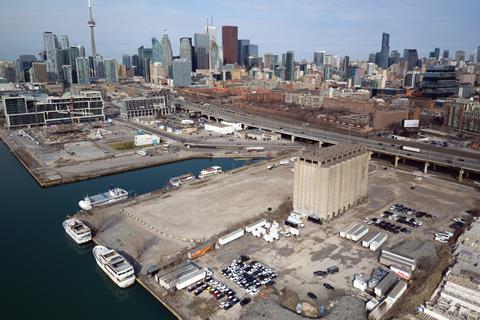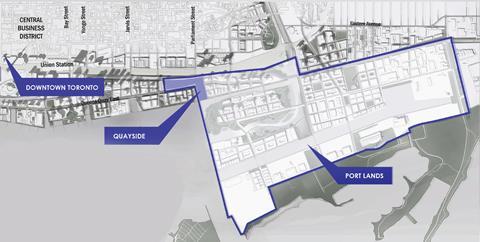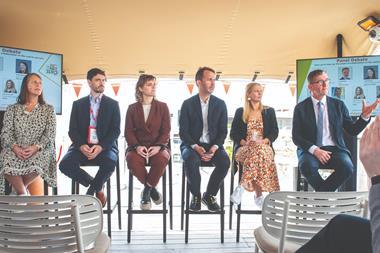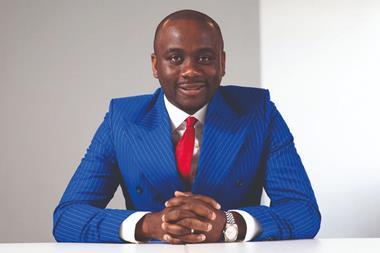Google has unveiled ambitious plans to transform Toronto into a smart city, complete with delivery robots and autonomous vehicles. Samuel Horti finds out how the plans are going down with the locals.
Walking into the venue where Google’s plans to build an 800-acre smart city in the heart of Toronto are being unveiled is like entering a giant Apple store.
An army of smiling greeters adorned in blue T-shirts asks how you are, where you’re from and whether you’d like to write a message about the search giant’s proposals on the whiteboards scattered around the lobby of the St Lawrence Centre for the Arts.
Many people have taken them up on the offer. “I’m excited about reducing our dependence on cars,” reads one message, alluding to the fleets of self-driving taxis and vans that Sidewalk Labs - a subsidiary of Google’s parent company Alphabet - will deploy. “I want to open up the waterfront,” says another.

However, this appears above a comment that sums up the general mood in the room: “I am curious and slightly sceptical.” And some locals are altogether hostile to the plans. They are concerned about the affordable housing and plans to collect data on residents, which they fear could lead to breaches of privacy. Outside the launch venue, protesters ring bells and hold signs with slogans bearing messages such as ‘Affordable for who?’.
So how likely is Google to win over the sceptics and turn its vision into reality?
It is no surprise that some people are anxious about the proposals. Sidewalk Labs, in partnership with public authorities, is planning to do no less than overhaul every aspect of urban living.
As well as self-driving cars, it wants to introduce underground robots that deliver your post and technology that can adjust the sizes of roads and pavements as necessary. It wants to use modular construction as standard, introduce flexible buildings that adapt to occupier demands and create office space that saves energy when not in use - and deliver up to 30% affordable housing while it is at it.
It intends to kick things off with a year-long, $50m (£38m) programme of pilots and testing. If that goes well, Sidewalk Labs and local government will partner with developers on phase one of the project, called Quayside, which will deliver 5.5m sq ft of space, around two-thirds of which will be residential. The entire 800-acre Eastern Waterfront area, owned by the city, will be next in line.
Bold vision
It is hard not to be drawn in by Sidewalk Labs chief executive Dan Doctoroff’s promise at the launch event of “a truly historic scheme” that will “bend the curve on virtually every element of quality of life”.
Doctoroff should know what he’s talking about: he was the deputy New York mayor in charge of overseeing the rebuilding of the World Trade Center after 9/11 and implementing one of North America’s largest-ever affordable housing programmes. He was also chief executive of Bloomberg until 2014, steering the company through the global financial crisis.
The gathering crowd certainly seems impressed by him and Will Fleissig, chief executive of Waterfront Toronto, the public sector segment of the partnership. Even the group that has been protesting outside seems satisfied with the answer it gets when it is its turn to take the microphone.

Clearly, there is general support for improvements and no wonder. The waterfront is strangely lifeless for a city otherwise so full of energy. People come here for work, to catch the ferry to Toronto Island Parks or to walk along the waterfront. But compared with other cities’ waterfronts, it is desperately lacking in shops, cafés and leisure spaces.
To the east, the area is especially barren as the high-rise condos give way to large industrial units, sprawling car parks and abandoned plots.
“It’s largely been a derelict industrial area that was underused and underdeveloped for many years,” says Bill Argeropoulos, principal at Avison Young Canada.
The hope is that this will all change as the city continues to evolve as the Canadian location of choice for banks and professional services firms as well as, more recently, tech companies. Google, Apple, Amazon, Microsoft and Cisco are all here alongside start-ups and they are looking for ever larger chunks of workspace as they capitalise on the growing pool of talented young professionals in the city.
This demand caused a development boom, with 22m sq ft of offices built over the past 10 years and even that hasn’t been enough. “The vacancy rate in Downtown is 2.7%, so we’re clearly in a landlords’ market,” Argeropoulos explains. “Tenants have very little wiggle room [on price] and options [for location] right now.”
Building a city ‘from the internet up’
Toronto is also desperately short of residential stock, particularly affordable housing. The population of Downtown is set to double within 25 years, but the city is already falling behind.
In 2010, it set a target to build 10,000 affordable rental homes and 20,000 affordable ownership homes by 2020. Seven years in, it has built less than a third of this and fewer than 1,000 affordable ownership homes. House prices have rocketed 33% in the past year alone and rents have risen 12%. Vacancy rates are less than half of New York City’s.
These shortages, combined with Toronto’s growing reputation as a global tech hub, make it the ideal proving ground for Sidewalk Labs’ plans to build a city, in its words, “from the internet up”.
As Fleissig explains to Property Week, the group will look to bring in property developers after a year of planning and small-scale pilots, with a view to getting started as soon as possible. “We’re going to talk to infrastructure groups, we’ll talk to developers, look at phasing and ask them what they think,” he elaborates. “Eventually, we’ll bring a few vertical developers on and do that first phase [at Quayside], and see how that works.”
The plans are as progressive as you would expect from a tech firm. The core concept is that this part of town will be packed with sensors collecting a variety of information, from pedestrian numbers to building usage, local weather and air quality.
That data will be analysed and then used to make real-time decisions about how the city can adapt. At any time, residents will be able to tap into that data and all the services that come with it by logging into their Sidewalk Labs accounts.
Driving down car numbers
The measures being piloted range from innovations in energy use and waste management to initiatives to make the public realm more flexible. But perhaps the most attention-grabbing goal is for less than one in five residents to own a car - the figure in the Greater Toronto Area currently sits at 78%.
This will be achieved through a range of different policies and technology. A fleet of on-demand, autonomous ‘taxibots’ and vans will ferry residents to wherever they need to go, minimising the need to own cars. If people do need to drive, they can rent vehicles using their Sidewalk Labs account, picking them up and then dropping them off as necessary.
Delivery vehicles will be absent from the streets, all freight being handled by a network of delivery robots zipping about underground, delivering post and packages straight to residents’ mail rooms.
Residents will be encouraged to walk and cycle around the neighbourhood via a network of footpaths and cycle lanes, as well as pavement overhangs that extend automatically when it is raining. And if the network of sensors detects increased usage by pedestrians as opposed to vehicles, it will automatically widen the safe walking area using a system of responsive LEDs.
Sidewalk Labs wants to pack every piece of smart city technology you have ever heard of into one space. To do that, it intends to embed technology companies that are at the cutting edge of urban design. Google will also move its headquarters to the area as a signal of intent.

However, Doctoroff stresses that he doesn’t simply want to turn the area into a “tech enclave”. He wants to solve real issues, the most pressing of which, he says, is to deliver affordable space for residents and businesses.
That requires innovation in real estate and will involve modular construction, flexible models of occupation, co-working and micro-units. It all revolves around a new building design model that Sidewalk calls ‘Loft’.
The concept requires strong building skeletons and minimalist interiors that can quickly adapt to changing population needs. It also involves modular façades, walls, floors and ceiling panels that can be reconfigured at short notice, with permanent structures such as support beams laid at five-metre intervals for maximum flexibility. A single building could incorporate residential, retail, manufacturing, office, hotel and parking space, with the proportions constantly shifting according to market demand.
“With sufficient ease of adjustment, a company could reconfigure a space to accommodate a week-long training seminar and then return it to offices or small conference rooms,” Sidewalk Labs explains. “A family might decide to subdivide a room to accommodate a visitor staying for a few months.”
It adds that the model would work especially well for retail, allowing the dimensions of shop units to be adjusted daily to fit a rotating line of pop-ups testing out their concepts.
Sidewalk Labs is going all out for modular construction, banking on the fact that the economies of scale it creates - and the flexibility of the buildings it produces - will generate long-term cost savings, even if the upfront costs are higher. These savings can be passed on to residents. To ensure success, Sidewalk Labs will spend the next year working up designs and methods with the world’s leading modular construction firms.
“Nobody has quite cracked modular,” Fleissig tells Property Week after the public meeting. “But we’re going to build 20,000 or 30,000 units, so why not try it here? We have a shot at doing something extraordinary.”
Shared ownership
But the cost savings from modular alone won’t be enough to deliver more affordable homes and Doctoroff knows it.
“If we don’t fundamentally address that issue, the whole notion of this being an inclusive community begins to fray,” he says at the meeting, adding afterwards that although he has no specific target for affordable housing, “in New York, in every re-zoning we did we achieved a range of 25% to 32%”.
To achieve those numbers, housing units in the Eastern Waterfront will be smaller. The company will build micro-units as small as 162 sq ft and pilot co-living developments. It believes that these models will reduce the costs of residential goods and services and save up to 70% of space, “offering tangible monetary benefits that will be passed on to residents”.
On the financing side, Sidewalk Labs will look at shared ownership and subsidised rent, drawing inspiration from schemes that Doctoroff used in his New York days, which largely involved convincing local government to give tax breaks and provide low-cost financing to developers delivering a certain number of affordable homes.
Overall, Avison Young’s Argeropoulos is impressed. “You’ll have one camp that says it’s about time that we have some forward-thinking ideas about our cities and you’ll have the sceptics asking whether this is a ‘Big Brother’ event, where almost every second of our lives will be monitored,” he says.
“There are benefits and drawbacks with everything that’s new. That’s what innovation is - it’s disruptive. But if we don’t innovate we become stagnant. This will definitely put Toronto on the map. When you talk about technology hubs globally, along with London and New York, [Toronto will be] a truly global city that’s really growing up.”

However, Sidewalk Labs will inevitably face huge hurdles, not least in the planning sphere. “Whatever they propose will have to convince the stakeholders,” says Argeropoulos. “We have a year of testing and there could be regulatory or municipal planning issues. There might be issues with how partnership agreements are made, including with transport authorities.”
Getting things through planning in Toronto takes “years”, Fleissig says, and the scheme’s novel approach to building design could prove more of a hindrance than a help.
The company will also have to battle through the red tape that comes with developing public sector land, all the while trying to convince officials to open up their chequebooks for affordable housing programmes.
It will have to contend with campaigners worried about privacy issues and convince the public that releasing their data is for their own good. And its plans to deliver affordable housing hinge on delivering flexible, modular construction units at a scale never seen before.
Doctoroff tells Property Week that he sees the biggest challenge as overcoming what he calls the “urbanist-technologist divide” between the way the two groups work in practice.
“They don’t speak the same language,” he says. “If we are truly going to mix visionary urban design with cutting-edge technology, we will have to conquer that.”
Bridging a gulf
This is echoed by Tom Redmayne, director of business development, UK and Ireland, at proptech firm WiredScore, which recently entered the Toronto market.
“Technology companies look at new ideas the whole time and work very quickly and disregard ideas if they don’t work,” he says. “Fundamentally, there’s such a disconnect between how they traditionally develop products and what real estate really is.
The ideas could be game-changing, but the reality of getting them integrated into a physical infrastructure is going to be a real challenge.”
That said, if the real estate industry is to change, the impetus is likely to come from a company like Sidewalk Labs rather than inside the industry, believes Redmayne.
“I very much believe that the people who change the real estate industry won’t be traditional realtors. If you look at the people changing the taxi industry it’s not taxi drivers; it’s Uber,” he elaborates. “So I think there’s room for real disruption and I think this could be a real starting point for that.”
Doctoroff is utterly convinced that the model can work and that in a year’s time, thanks to small-scale pilots of the various technologies Sidewalk Labs intends to deploy at Quayside, the people of Toronto will agree.
Find out more - Smart cities: smart thinking
“At the end of the year, if you don’t like it, if Waterfront Toronto’s board doesn’t like it, if elected officials don’t like it, they can tell us to go away,” he says. “But we have convinced ourselves that the opportunity to improve quality of life is so significant that people are going to be really excited. That’s what we’re betting on.”
And what a big bet it is. While the financial cost of failure for Sidewalk Labs will be negligible - $50m is a drop in the ocean to parent company Alphabet - it could be devastating for the vision that they are trying to push.
Failure to capture the imagination of Toronto’s public over the next year would be a huge setback not just for the company’s plans for urban living, but also for the very notion of smart cities.
After all, if a company like Google cannot get it right in a city as ripe for redevelopment as Toronto, who can?































No comments yet